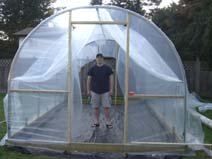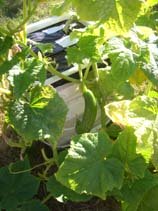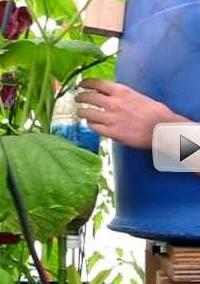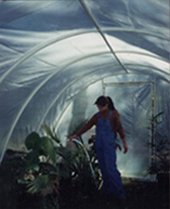|
Container Gardening: Greenhouses, Urban Sprawls and Self-watering.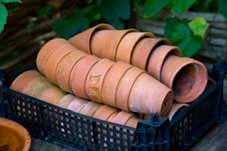
Container gardening is a huge benefit in city and greenhouse gardening, it allows many people who would normally not be able to grow their own food the option, especially in the instance of Urban Gardening. Growing container vegetables does not take up a lot of space and can be done virtually everywhere. Land is no longer necessarily needed to grow healthy vegetables. Greenhouses and Container Gardening:Since it is nice to have plants on benches it is better to use containers for growing in a greenhouse. This also increases the amount of space in the greenhouse that can be used for growing plants. Just as it is with Urban Gardening, greenhouse gardening is about making the most of the space that is available. 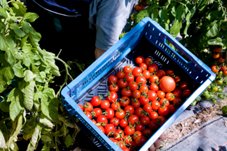
Container vegetable gardening:Container gardening allows so many more people the chance to get involved with gardening. Vegetables can pretty much be grown anywhere; there is nothing that the plant needs that cannot be offered to the plant in a container. The Benefits
Containers:A container is a container. Anything can be used for growing a plant. I have heard of people growing in bathtubs, pretty funny anything can be used to grow plants….. even the kitchen sink ;) (I know pretty week). The only rule of thumb would be to make sure that the container that is decided on is the right size for the plant being grown. Again, it’s suggested to start with knowing as much about the plant that will be grown, and choosing a size of container from there.
Soil:Soil, next to the plant itself, is the most important part of any container gardening setup. Plants can be grown in pretty much any kind of container, but more care has to be spent in choosing the growing medium. It definitely helps to know as much about the plant that is being grown, this will help to ensure that the proper mix is being used.
And for a fun look at Dirt or Soil take a look at this movie trailer: Dirt the movie - See the Trailer here Fertilizer:Fertilizer also plays a big role in container gardening. Since the containers are relatively small there is not very much soil or growing medium, so as the soil and nutrients leach out of the soil by constant watering of a small pot, these nutrients need to be replaced. Hydroponics is basically feeding plants exactly what they need through a nutrient solution, without a nutrient containing growing medium. Watering: Containers often loose moisture quickly and some may need to be watered daily, especially during hot summer days. If you are interested in growing in the ground as well, with little fuss over getting started, I highly recommend that you take a look at Jonathan White's system: Compost and Gardening System: Food 4 Wealth - ReviewSelf Watering Containers: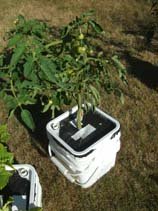 Self watering Containers are a great addition or alternative to conventional containers as they automatically supply the plant with exactly the amount of water that the plant basically wants.
Self watering Containers are a great addition or alternative to conventional containers as they automatically supply the plant with exactly the amount of water that the plant basically wants.Since the water reservoir is kept at the bottom, the water that is sucked up into the growing portion of the pot never leaches the soil of its nutrients. A ring of organic fertilizer can be placed on the soil around the top of the plant providing a slow release of fertilizer, and since the growing medium is never leached of nutrients (since they are not watered from above), the medium remains nutrient rich. Perfect watering + Nutrient Rich Soil = very happy well producing plants I was able to grow very large healthy tomato plants in these self-watering containers. They are the best of both worlds between container gardening and Hydroponics. 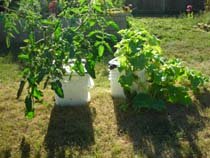
Didn’t matter the plants were healthy large and produced many tomatoes. I barely watered them I didn’t have to weed and they stayed healthy and produced a lot of vegetables. Bigger pots for next crop, I foresee an even bigger yield. The pot is designed to retain as much water as possible, the root system is fully contained allowing for very little evaporation and loss of water, with the plastic layer sealing the top of the root system. Container Gardening is very rewarding and is something for every Urban or greenhouse gardener. From Container Gardening to Urban Gardening |
Please Help Us Get Social:
Valued Links and Featured Sites:
Greenhouse Plans
Free Greenhouse Gardening Construction Plans
"Ole Dirt Farmer"

Self Watering Container Plans
Don't want to make your own. There is also information about Earthboxes too.
These are great, either or.
Free Self Watering Container Plans
Jonathan White: Food 4 Wealth
It is a great fit. Be sure to take a look. Jonathan is a passionate guy. See below for our full review.
Aquaponic Plans
Links on this page will take you to Travis's free e-book.
A Malispina college student shares a video of her completed Barrelponic project. Complete with Tilapia.
Free Aquaponics (Fish and Vegetables) Plans






